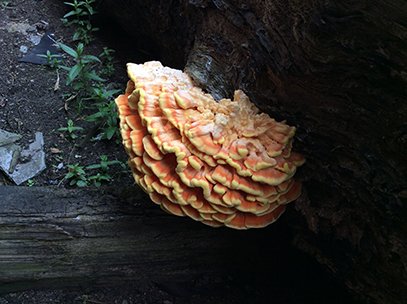Wood destroying fungi: Chicken of the Woods (Laetiporous Sulphureus)
Outside the workshop, we have large oak felled by the nearby farm workers some time ago. Being right next to the picnic table, we recently noticed this stunning species of fungi living off the decaying log.
It has a rather cool name ‘Chicken of the Woods’ and grows mainly on oak, but can be found on cherry, sweet chestnut, beech, willow and yew. UK Wild food sites say that it’s edible, and is said to taste... well…. like chicken! Although it’s best eaten young (bright yellow to orange as opposed to older specimens which are dull yellow to white) as the older specimens become woody and acrid to taste. Also, if it’s growing on Yew – steer clear of it! When growing on Yew, Chicken of the Woods takes in the very poisonous Taxine and Taxane of the Yew. We wouldn’t advise making a meal out of it and it certainly won’t be featuring in our lunches, as 20% of people are sensitive to eating this mushroom and become ill after consumption!
Chicken of the Woods (Laetiporous Sulphureus) is a saprotrophic (wood decay) fungus. Saprotrophic fungi do the job of decaying logs and stumps, recycling the nutrients for other organisms. This fungus can colonise both living and dead trees, acting as a weak pathogen on living trees. It’s said to be one of the easiest fungi to recognise, with its large size and striking sulphur-yellow to orange colour and wavy edged cap.
As woodworkers, the fungi that concern us are the species that digest their food from trees and the timber cut from them. Wood destroying types of fungi live off the cell walls of the wood, causing the structure to decompose and eventually collapse.
Wood rotting fungi differ in their optimum temperature for breeding, but the majority thrive at temperatures between 20 to 30c and fungus is rapidly killed above 40c. One of the benefits of wood-drying kilns is that the temperatures employed in the process typically kill all the fungi and insects if a maximum dry-bulb temperature of above 60 is used for the drying schedule.
On our long course, Jane Cleal’s theory lessons in timber technology touch on wood rotting fungi, wood boring insects and their controls. The syllabus also covers the various methods of seasoning wood, and this is usually tied in with a visit to a timber yard to look at best drying practices, timber storage and how to select the best timber.
We aim to give you the knowledge and the skills to select the finest quality and healthiest timbers for your projects going forward, and to arm you with the knowledge of what to look out for in timber selection and preparation.
For this oak log, the time has long passed where we could salvage it for timber, but at least we can enjoy the colourful show from the fungi that live on it!


